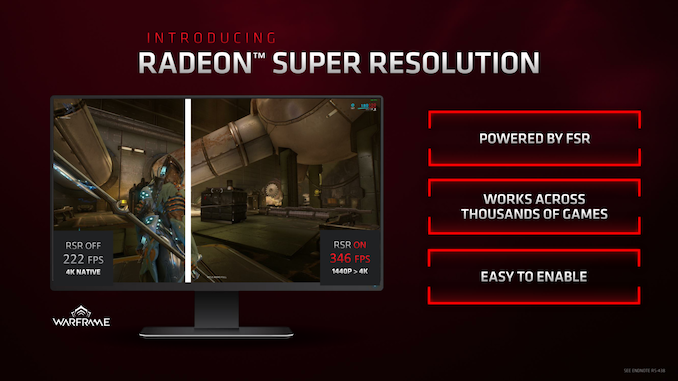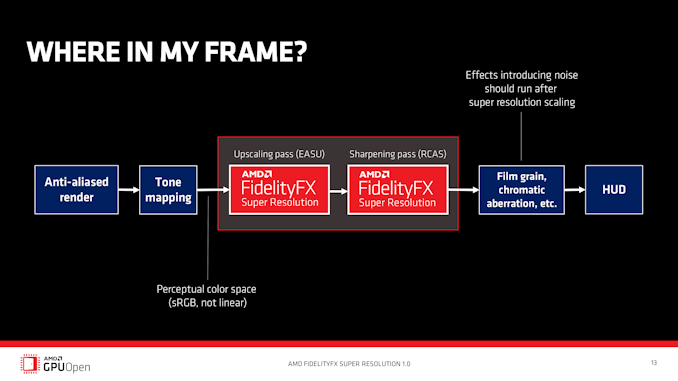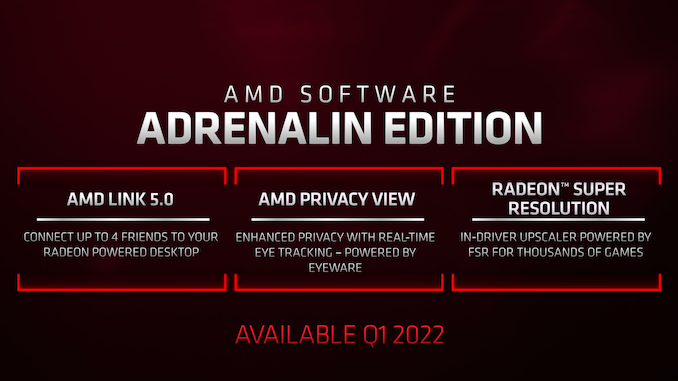AMD’s FidelityFX Super Resolution To Become Driver Feature: Radeon Super Resolution
by Ryan Smith on January 4, 2022 10:43 AM EST
As well as delivering hardware updates for both their desktop and mobile lineups this morning, as part of AMD’s CES 2022 keynote, the company also offered a quick update on their Radeon driver plans for the first quarter of the year. The big takeaway here is that AMD is going to be expanding the accessibility of their FidelityFX Super Resolution image upscaling technology by integrating it into their drivers as a forced override option. Slated to land in a future version of AMD’s driver stack this quarter, the driver-based feature will be promoted as Radeon Super Resolution.
As a quick refresher, AMD first released their spatial image upscaling technology, FidelityFX Super Resolution (FSR), back in June. As part of the company’s suite of open source FidelityFX libraries, game developers were free to integrate the image upscaling algorithm into their games by including AMD’s shader program as a step in their image rendering pipeline. The net results of FSR have been mixed from an image quality standpoint, but the shader-based approach is very cheap to execute, and it can be used on a wide range of GPUs (including NVIDIA and Intel parts).
AMD has been quick to score a number of developers who have included FSR within their games, but even then, PC gamers have been interested in applying it to additional games. In the last several months this has led to the introduction of utilities like Magpie and Lossless Scaling, which can force various image upscaling techniques on games, including AMD’s FSR. And while forcing FSR in this fashion isn’t ideal from a quality or compatibility standpoint (leading to AMD originally passing on the idea), AMD has since come around on the idea. To that end, AMD will be implementing a form of FSR in their drivers as an override option, which they will be calling Radeon Super Resolution (RSR).
As with Magpie and similar utilities, this will be a forced upscaling option that is implemented at the end of the rendering pipeline, rather than the more ideal mid-point. The ramifications of which are that RSR will be upscaling not just the image from the game, but the UI as well; so it will introduce some of the same UI distortion as running a game at a sub-native resolution to begin with.

It's Ideal To Run FSR Before Post-Processing Effects and the UI, But It's Not Required...
All of which is fitting, since that’s essentially what you have to do to make RSR work. Since this is a driver-forced feature, games need to be set to a sub-native rendering resolution in order to provide something to upscale – as well as to provide the performance benefits of rendering at a lower resolution. So using RSR won’t quite be a set-it-and-forget-it situation as games with proper FSR support offer today, but adjusting a game’s rendering resolution is about all the real work that’s required from the user.
At this point AMD is expecting it to work with most games. But like all driver override features like this, it may not work (or at least, not work well) with all games. In particular, it will require that a game supports and is running in exclusive fullscreen modes. So although AMD fully supports RSR, there is certainly an element of Your Mileage May Vary with respect to compatibility.
In the meantime, it should be noted that FSR itself won’t be going anywhere. As RSR itself is essentially a fallback implementation of FSR to force it at the driver level, properly integrating FSR into a rendering pipeline is still the best and most ideal way to use it. So RSR is not replacing FSR; rather it’s giving Radeon owners another way to access some of FSR’s functionality.
Moving on, AMD also has a couple more features slated for their forthcoming driver update that bear mentioning. First and foremost, AMD Link 5.0 is on its way. AMD’s remote game streaming feature was most recently updated with AMD Link 4 back in the spring, and now AMD is preparing the next iteration.
Finally, AMD will also be integrating a new feature called AMD Privacy View, which in turn will be based on licensed software from Eyeware. The basis behind Privacy View is that by using eye tracking and head tracking, AMD’s drivers will be able to determine what the user is looking at – and in the process deter shoulder surfers from being able to easily see a user’s screen. According to AMD, both this and AMD Link 5.0 are expected to land in AMD’s drivers in the first quarter of this year.











3 Comments
View All Comments
Oxford Guy - Tuesday, January 4, 2022 - link
'The basis behind Privacy View is that by using eye tracking and head tracking, AMD’s drivers will be able to determine what the user is looking at'That's privacy.
yetanotherhuman - Wednesday, January 5, 2022 - link
A simple shader based sharpener is not going to compete with DLSS 2+; they need to work on a real competitor to it.Spunjji - Thursday, January 6, 2022 - link
That's not really what FSR is - I do suspect they're on that, though